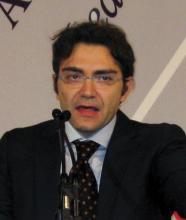CHICAGO – Drug-eluting stents are as safe as bare-mental stents when implanted in patients with large-vessel coronary artery disease, according to results of the BASKET-PROVE trial.
At 2 years of follow-up, the rates of death from cardiac causes or nonfatal myocardial infarction did not differ significantly, at 2.6% for patients implanted with sirolimus-eluting stents, 3.3% for those given everolimus-eluting stents, and 4.8% for those with bare-metal stents. Moreover, there were no significant differences between those groups in the rates of stent thrombosis.
However, the use of drug-eluting stents reduced the need for target vessel revascularization by more than 50%, Dr. Christoph Kaiser reported in a late-breaking clinical trial session at the annual scientific sessions of the American Heart Association.
The BASKET-PROVE data were simultaneously published online by the New England Journal of Medicine (N. Engl. J. Med. 2010 Nov. 16 [doi: 10.1056/NEJMoa1009406]).
Any target-vessel revascularization occurred in 4.3% of patients implanted with sirolimus releasing stents, in 3.7% of patients with everolimus-eluting stents, and in 10.3% of those with bare metal stents in the BASKET-PROVE (Basel Stent Kosten-Effektivit?ts Trial-Prospective Evaluation Examination) trial.
The European trial was launched after a retrospective analysis of data from the original BASKET trial suggested that patients who underwent large-vessel stenting with sirolimus-eluting or paclitaxel-eluting stents were at increased risk of cardiac death and myocardial infarction at 6 months and beyond.
The 2,314 patients in BASKET-PROVE were randomized to first-generation sirolimus-eluting stents (Cypher Select) or second-generation everolimus-eluting stents (Xience V) or bare-metal cobalt-chromium stents. All stents were at least 3.0 mm in diameter.
"In patients with large-vessel artery disease, the late safety problems of drug-eluting stents could no longer be confirmed and there was even a trend in the opposite direction," Dr. Kaiser, head of interventional cardiology at University Hospital Basel, Switzerland, said during a press briefing at the meeting.
Invited discussant Dr. Marco Valgmigli, chair of cardiology, Cardiovascular Institute, Azienda Opedaliero Universitaria di Ferrara, Italy, said the data are highly reassuring, but not conclusive, because "the trial is technically underpowered." He pointed out that the study was based on a cardiac death/MI event rate of 6% in the bare-metal group and 10.5% in the two drug-eluting arms, with a type II error of 20%. The observed event rate was indeed 20% lower in the bare-metal group and more than 70% lower in the drug-eluting stents.
Dr. Kaiser responded that the confidence intervals observed in the trial rule out the potential for any harm with drug-eluting stents in contemporary stenting.
The different findings from the BASKET and BASKET-PROVE trials could reflect longer clinical experience with drug-eluting stents, technical factors during surgery, and the use of dual antiplatelet therapy with aspirin and clopidogrel for 12 rather than 6 months, as in the original BASKET trial, Dr. Valgmigli suggested.
Press briefing moderator Dr. Elliott Antman, with Harvard Medical School in Boston, said he is less concerned now about placing drug-eluting stents in large vessels with respect to late risks, and that the major benefit for patients will be the reduction in target vessel revascularization.
"What they need to know is that the chance for having to come back to the hospital for target vessel revascularization is clearly higher, about twice as high, with bare-metal stents," he said in an interview. "What we’re getting from the drug-eluting stent in this situation is reducing target vessel revascularization, which may be very meaningful for patients because they want to travel and don’t want to worry about having to have another procedure in a year or two."
An unadjusted exploratory analysis revealed no significant differences in the primary end point of cardiac death and MI between patients receiving first- or second-generation drug-eluting stents, Dr. Kaiser reported.
In all, 28 (3.6%) patients with sirolimus-eluting stents died vs. 25 (3.2%) with everolimus-eluting stents and 34 (4.4%) with bare-metal stents. Death from cardiac causes was also similar at 1.7%, 1.7% and 2.9%, respectively.
A nonfatal MI occurred in seven patients with sirolimus-eluting stents, compared with 13 patients with everolimus-eluting stents and 20 with bare-metal stents.
"Since the performance of first- and second-generation drug-eluting stents was similar, both drug-eluting stents may be used in these patients," he said.
Dr. Valgmigli said that comparison between the first- and second-generation stents should be interpreted as purely exploratory since it was not adjusted for type I or type II errors.
The number of stents per patient was similar at 1.6 vs. 1.7 vs. 1.7, respectively, as was the number of treated segments per patient (1.4 vs. 1.4 vs. 1.5) and total stent length per patient (30 mm vs. 31.1 mm vs. 31.1 mm).

